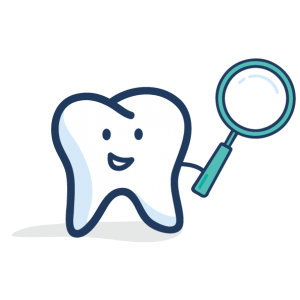Taking Care of Your Child’s Teeth
- Baby teeth are very important and need to be protected from tooth decay early in life.
- Your mouth contains germs that can cause your baby to get tooth decay. Your baby can catch germs from your mouth from contact with your saliva. Do not share spoons, cups or toothbrushes with your child. Avoid cleaning his/her pacifier with your mouth.
- Children who have early tooth decay or lose teeth too soon have more dental problems in their adult teeth. Tooth decay is preventable!
What is tooth decay and how does it happen?
Often called a cavity, tooth decay is caused when two things come in contact with teeth:
1. Sugars, starches or simple carbohydrates. Foods with simple carbohydrates include:
- White bread
- White pasta
- Cakes, pastries and many baked goods
- Packaged cereals
- Germs (bacteria)
2. Germs live in a sticky film of food called plaque. Plaque forms on the teeth all of the time and can make your teeth feel fuzzy.
When the germs in the plaque come in contact with sugary and starchy foods, acid attacks the teeth. The acid can lead to tooth decay and cause cavities (holes) in the teeth. The germs in the plaque are the enemy!
There are many ways to take care of your child’s teeth
You can protect your child’s teeth with 4 simple steps:
- Toothpaste:Use toothpaste that contains fluoride. Twice daily brushing with fluoride toothpaste protects teeth from tooth decay.
- Fluoride Varnish: Have a medical doctor, dentist, dental hygienist or nurse apply fluoride varnish to your child’s teeth to help prevent tooth decay and even reverse early tooth decay.
- Diet: Serve healthy foods and avoid sugary drinks and snacks.
- Dental Checkups: Have a medical doctor or dentist check your child’s teeth by age one and then on an on-going basis.
Tips on caring for your child’s teeth and mouth based on their age:
Before Teeth
- Even newborn babies need to have their mouths cleaned. Before your baby has teeth, gently wipe the gums clean with a clean, damp washcloth each day.
When Teeth Appear – usually around 6 to 10 months
- Brush teeth twice a day with a small amount of fluoride toothpaste the size of a grain of rice using an infant toothbrush
- You can brush your child’s teeth anywhere – not just in the bathroom. It can be easier to brush a baby’s teeth while he/she is lying down on a changing table or on the floor.
- Introduce a sippy cup when your child can sit up on his/her own. Limit juices, breast milk and formula to mealtime only.
- If you put your baby to bed with a bottle, fill it with water only. Milk, formula, juices, soda and breast milk all have sugar in them that can puddle around a sleeping baby’s teeth, causing tooth decay.
1-3 Years Old
- Continue to brush teeth twice a day with a small amount of fluoride toothpaste, the size of a grain of rice
- Allow your child to decide where tooth brushing will take place.
- Make brushing teeth fun by singing for two minutes, using a tooth timer, or watching a tooth brushing video online
- Allow your child to choose his or her own toothbrush and toothpaste at the store.
- Ask your child’s medical doctor or dentist about a simple fluoride application that can be given at the office.
- Wean baby from the bottle by age 1. Now your baby should be drinking water from a sippy cup. Offer your child milk in a sippy cup during mealtimes as well as a maximum of 4 ounces of 100% fruit juice per day. When your child is not having a meal, the sippy cup should only contain water.
- Check your baby’s teeth for spots and stains. Ask your child’s medical doctor or dentist about any problems you notice.
- Children should have their first dental check up by age 1. Schedule a visit with a dentist or ask your child’s medical doctor to look at their teeth.
3-6 Years Old
- Brush your child’s teeth twice a day with a small amount of fluoride toothpaste.
- Your child can now use a little more fluoridated toothpaste than before – the size of a pea.
- When purchasing toothbrushes, be sure that they are the correct size for your child. As your child grows, the toothbrush you use should grow too.
- Let your child start learning to brush his own teeth, but be there to help.
- Ask your child’s medical doctor or dentist about a simple fluoride application that can be given at the office.
- Limit juice drinks to 4-6 ounces per day to help prevent tooth decay.
- Start flossing your child’s teeth once a day as soon as he/she has two or more back teeth that touch.
- Schedule visits with your child’s dentist.
Losing Teeth
Between the ages of 6 and 12 years, your child will start losing baby teeth. During these years, your child’s smile will have both adult and baby teeth. When teeth fall out, they can fall out in any order.
Adult Teeth
Usually the middle teeth (central incisors) are the first to come out around age 6 to 7 years.
- The ones on the sides of the middle teeth (lateral incisors) come out around age 7 or 8.
- Molars and canines can be lost at any time after age 8, and will be gone by age 9 to 12.
Around age 12 years, your child will have a set of 28 permanent, adult teeth.
Be sure to inspect your child’s teeth for signs of decay. If you see something that concerns you, call a dentist right away.
